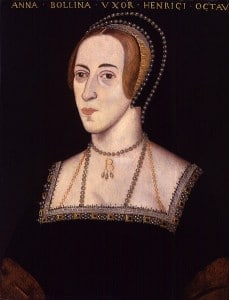 I am convinced that the removal of Anne Boleyn from her position as Queen by execution was a foregone conclusion and that Anne never stood a chance of clearing her name and escaping death. There was shock at the allegations against Anne Boleyn and the five men, as shown in a letter from Rowland Lee, Bishop of Coventry and Lichfield, written on the 7th May 1536, acknowledging receipt of letters from the Privy Council:-
I am convinced that the removal of Anne Boleyn from her position as Queen by execution was a foregone conclusion and that Anne never stood a chance of clearing her name and escaping death. There was shock at the allegations against Anne Boleyn and the five men, as shown in a letter from Rowland Lee, Bishop of Coventry and Lichfield, written on the 7th May 1536, acknowledging receipt of letters from the Privy Council:-
“As the news in this letter is very doleful to this Council and all the liege people of this realm, God forbid it should be true.”1
but records of another letter written on the same day by Sir Henry Wyatt to his son Thomas Wyatt, who was a prisoner in the Tower, show how Anne’s guilt was generally accepted:-
“Considers himself most unfortunate that he cannot go nor ride without danger to his life, or do his duty to the King in this dangerous time that his Grace has suffered by false traitors. Desires his son to give the King due attendance night and day. “I pray to God give him grace long to be with him and about him that hath found out this matter, which hath been given him of God, and the false traitors to be punished according to justice to the example of others.” Alington, 7 May.”2
Henry Wyatt believed in his son’s innocence but seemed convinced of the guilt of “the false traitors”, Anne Boleyn, Henry Norris, Sir Francis Weston, William Brereton, Mark Smeaton and Anne’s brother, George Boleyn. They had had no trial but the fact that Sir Henry believed in his son and did not believe in the innocence of the others implies that their guilt was generally accepted by people. If Cromwell had arrested Sir Thomas Wyatt and Sir Richard Page, and questioned Sir Francis Bryan for show, and to make people believe that he was investigating the case thoroughly, then his plan had worked.
Shall I Die Without Justice
On entering the Tower of London on the 2nd May 1536, Anne Boleyn had asked Sir William Kingston, the Constable of the Tower, “shall I die with]yowt justes?”3 (“shall I die without justice?”) and although Sir William Kingston replied that “the porest sugett the Ky[ng hath, hath justice”4 (the poorest of the King’s subjects has justice), Anne’s laugh at his statement shows that she did not believe him. Just as I am convinced that Anne’s conviction and execution were foregone conclusions, I also think that she was intelligent enough to realise this, even at this early.
Why do I think that it was all a foregone conclusion?
 Well, I will be writing more about this as I examine the indictments, the trials and the ends of Anne and the five men in the next week or so, but here are a few reasons:-
Well, I will be writing more about this as I examine the indictments, the trials and the ends of Anne and the five men in the next week or so, but here are a few reasons:-
- The Commissions of Oyer and Terminer – Two commissions of oyer and terminer were set up on the 24th April 1536 by Cromwell and Audley to cover criminal offences in the counties of Kent and Middlesex, the two counties which were the locations of the alleged criminal offences committed by Anne Boleyn and the five men in the indictments. Coincidence? I think not, particularly when you consider how rarely these commissions were used.
- Parliament – On the 27th April 1536 writs were issued summoning Parliament and a letter was sent to the Archbishop of Canterbury asking him to attend Parliament. This was followed up on the 7th May 1536 by letters being sent out to every sheriff in England explaining that:-
“since the dissolution of the late Parliament matters of high importance have chanced, which render it necessary to discuss the establishment of the succession in a Parliament assembled for that purpose. Writs have been already sent, which the King doubts not he will execute. Desires him to declare to the people that the calling of a Parliament is so necessary, both for the treating of matters tending to their weal and the surety of our person, that they will have cause to think their charge and time, which will be very little and short, well spent. Desires him to take care that persons are elected who will serve, and for their worship and qualities be most meet for this purpose.” Westm., 7 May. Signed with a stamp5. The fact that the succession is mentioned suggests that there was going to be some change in the succession and Alison Weir believes that these writs summoning Parliament were “paving the way for any legal process against the Queen to be formally endorsed.”6 - The dates on the indictments – I have discussed the dates on the indictments previously, pointing out that the dates used just make no sense. Eric Ives, in “The Life and Death of Anne Boleyn”, writes of how “three quarters of these specific allegations can be disproved. In twelve cases Anne was elsewhere or the man was”7 and he goes on to conclude that “the detailed particulars of Anne’s adultery were thus fiction.”8 Although Bernard argues that the dates were probably just guesswork by the lawyers, in that witness could not be expected to remember specific dates of events, I am of the opinion that the sloppiness of these indictments shows that the guilt of Anne Boleyn, Smeaton, Norris, Brereton, Weston and Rochford was a foregone conclusion, dates did not matter. If the prosecution wanted to present a cast iron case against Anne in a fair and just court then they would have been more careful in picking the dates and at least avoided dates where Anne was recovering from childbirth or where she was with the King! The dates did not matter, Anne was deemed guilty before she ever set foot in that Tower or court room.
- Henry VIII’s behaviour – Chapuys wrote that “the King has shown himself more glad than ever since the arrest of the Concubine, for he has been going about banqueting with ladies, sometimes remaining after midnight, and returning by the river”9. His merrymaking at such a time is rather tasteless and wouldn’t the cuckolded husband be distraught at the love of his life betraying him? No, not if it wasn’t true and he had had conspired against her. Being seen to be seeing other women at this time, rather than being in the company of his mistress Jane Seymour, may well have been a tactic on Henry’s part, he may have been distancing himself from Jane Seymour so that he didn’t look like the baddie, the man who was getting rid of one wife for a new model. Jane Seymour was actually given lodgings within a mile of the King’s residence so that they could see each other easily.
Chapuys also wrote to Charles V on the 19th May: “I hear that, even before the arrest of the Concubine, the King, speaking with Mistress Jane Semel[Seymour] of their future marriage, the latter suggested that the Princess should be replaced in her former position;”10, so Henry had mentioned marriage to Jane Seymour before Anne was even arrested on the 2nd May! Court gossip perhaps but it’s interesting nonetheless. - The Sword of Calais – As I have discussed before, the French swordsman had to have been ordered days before Anne’s trial, before she was even found guilty. Weir suggests that he would have been ordered on the 14th at the latest and possibly as early as the 9th or 10th11.
- Anne Boleyn’s household was broken up on the 13th May, before her trial – Why break up her household if she could still be found innocent?
- The speed of events – Less than a month after the commissions of oyer and terminer were set up the Queen was dead and the King had a new wife just 11 days after Anne’s death. Could thorough investigations really be carried out in such a short time? The Catherine Howard affair blew up in November 1541 yet Catherine was not executed until the 13th February 1542, so how and why did events move so fast in Anne’s case? Hmmm…
So, Anne Boleyn died without justice. Even though she was tried in front of a jury of her peers, she did not receive justice in any sense of the word. While she was in court fighting for her life, the Sword of Calais was on his way to do his job and execute her, and Archbishop Cranmer was organising the annulment of her marriage to the King. Her guilt and her death were foregone conclusions as far as Cromwell, the King and the jury were concerned, I hope they were haunted by their actions.
Happy Mother’s Day
Just to say Happy Mother’s Day to those of you in the USA and other countries which celebrate it this weekend. I wrote a post, Anne Boleyn: The Mother, back in March for the UK Mother’s Day so do have a read of it. Have a great weekend!
Notes and Sources
1 – LP x. 820 Letter from Roland Lee, Bishop of Coventry and Lichfield, to Cromwell, 7th May 1536
2 – LP x. 819 Sir Henry Wyatt to his son Thomas Wyatt
3 and 4 – LP x.793
5 – LP x.815 Letter from Henry VIII to Sheriffs, 7th May 1536
6 – The Lady in the Tower: The Fall of Anne Boleyn, Alison Weir, p94
7 and 8 – The Life and Death of Anne Boleyn, Eric Ives, p344
9 – LP x.908
10 – Ibid.
11 – The Lady in the Tower: The Fall of Anne Boleyn, Alison Weir, p240